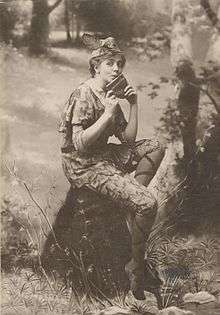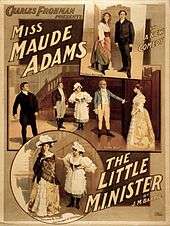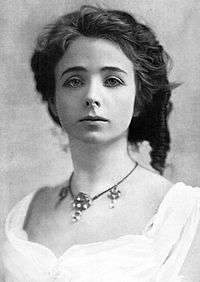Maude Adams
| Maude Adams | |
|---|---|
|
Maude Adams, 1901 | |
| Born |
Maude Ewing Adams Kiskadden November 11, 1872 Salt Lake City, Utah, U.S. |
| Died |
July 17, 1953 (aged 80) Tannersville, New York, U.S. |
| Occupation | Actress |
| Years active | 1880–1916 |
| Signature | |
|
| |
Maude Ewing Adams Kiskadden (November 11, 1872 – July 17, 1953), known professionally as Maude Adams, was an American actress who achieved her greatest success as the character Peter Pan, first playing the role in the 1905 Broadway production of Peter Pan; or, The Boy Who Wouldn't Grow Up.[1] Adams's personality appealed to a large audience and helped her become the most successful and highest-paid performer of her day, with a yearly income of more than one million dollars during her peak.[1][2]
Adams began performing as a child while accompanying her actress mother on tour. At age 16, she made her Broadway debut, and under Charles Frohman's management, she became a popular player alongside leading man John Drew, Jr. in the early 1890s. Beginning in 1897, Adams starred in plays by J. M. Barrie, including The Little Minister, Quality Street, What Every Woman Knows and Peter Pan. These productions made Adams the most popular actress in New York. She also performed in various other plays. Her last Broadway play, in 1916, was Barrie's A Kiss for Cinderella. After a 13-year retirement, she appeared in more Shakespeare plays and then taught acting in Missouri. She finally retired to upstate New York.
Early life and career

Adams was born in Salt Lake City, Utah, the daughter of Asaneth Ann "Annie" (née Adams) and James Henry Kiskadden. Adams' mother was an actress, and her father had jobs working for a bank and in a mine.[3] Little else is known of Adams's father, who died when she was young.[4] James was not a Mormon, and Adams once wrote of her father as having been a "gentile". The surname "Kiskadden" is Scottish.[5] On her mother's side, Adams's great grandfather Platt Banker converted to Mormonism and moved his family to Missouri, where his daughter Julia married Barnabus Adams. The family then migrated to Utah, settling in Salt Lake City, where Maude's mother was born. Adams was also a descendant of Mayflower passenger John Howland. The extent of Adams's connection to The Church of Jesus Christ of Latter-day Saints is unclear. Adams took long sabbaticals in Catholic rectories, and in 1922 she donated her estates at Lake Ronkonkoma to one of these places, the Sisters of St. Regis, for use as a novitiate and retreat house.[6][7]
Adams appeared on stage at two months old in the play The Lost Baby at Brigham Young Theatre.[8] She appeared again at the age of nine months in her mother's arms. Over her father's objections, Adams began acting as a small child, adopting her mother's maiden name as her stage name. They toured throughout the western U.S. with a theatrical troupe that played in rural areas, mining towns and some cities.[3] At the age of five, Adams starred in a San Francisco theater as "Little Schneider" in Fritz, Our German Cousin and as "Adrienne Renaud" in A Celebrated Case.[2] She debuted in New York at age ten in Esmeralda and then returned to California. Adams later wrote a short essay, "The One I Knew Least", where she described her difficulty in discovering her own personality while playing so many theatrical roles as a child. She briefly returned to Salt Lake City, where she lived with her grandmother and studied at the Salt Lake Collegiate Institute.[3]
Early adult career

Adams returned to New York City at age 16 to appear in The Paymaster. She then became a member of E. H. Sothern's theatre company in Boston, appearing in The Highest Bidder, and then was on Broadway in Lord Chumley in 1888. Charles H. Hoyt then cast her in The Midnight Bell where audiences, if not the critics, took notice of her. In 1889, sensing he had a potential new star on his hands, Hoyt offered her a five-year contract, but Adams declined in favor of a lesser offer from the powerful producer Charles Frohman who, from that point forward, took control of her career. She soon left behind juvenile parts and began to play leading roles for Frohman,[3] often alongside her mother.[9] In 1890, Frohman asked David Belasco and Henry C. de Mille to specially write the part of Dora Prescott for Adams in their new play Men and Women, which Frohman was producing. The next year, she appeared as Nell in The Lost Paradise.
In 1892, John Drew, Jr. (one of the leading stars of the day) ended his eighteen-year association with Augustin Daly and joined Frohman's company. Frohman paired Adams and Drew in a series of plays beginning with The Masked Ball and ending with Rosemary in 1896. She then spent five years as the leading lady in John Drew's company.[10] There, "her work was praised for its charm, delicacy, and simplicity."[3] The Masked Ball opened on October 8, 1892. Audiences came to see its star, Drew, but left remembering Adams. Most memorable was a scene in which her character feigned tipsiness for which she received a two-minute ovation on opening night. Drew was the star, but it was for Adams that the audience gave twelve curtain calls, and previously tepid critics gave generous reviews. Harpers Weekly wrote: "It is difficult to see just who is going to prevent Miss Adams from becoming the leading exponent of light comedy in America. The New York Times wrote that Adams, "not John Drew, has made the success of The Masked Ball at Palmer's, and is the star of the comedy. Manager Charles Frohman, in attempting to exploit one star, has happened upon another of greater magnitude." The tipsy scene started Adams on her path to being a favorite among New York audiences and led to an eighteen-month run for the play.
Less successful plays followed, including The Butterflies, The Bauble Shop, Christopher, Jr., The Imprudent Young Couple and The Squire of Dames. But 1896 saw an upturn for Adams with Rosemary. A comedy about the failed elopement of a young couple, sheltered for the night by an older man (Drew), the play received critical praise and box office success.[11]
Barrie and stardom

Frohman had been pursuing J. M. Barrie (the future author of Peter Pan) to adapt the author's popular book The Little Minister into a play, but Barrie had resisted because he felt there was no actress who could play Lady Babbie. On a trip to New York in 1896, Barrie attended a performance of Rosemary and at once decided that Adams was the actress to play Lady Babbie.[11][12] Frohman worried that the masculine aspects of the book might overshadow Adams's role. With Barrie's consent, several key scenes were changed to favor Lady Babbie.[13] The play opened in 1897 at the Empire Theatre and was a tremendous success, running for 300 performances in New York (289 of which were standing room only) and setting a new all time box office record of $370,000; it made Adams a star.[14][12] It also toured successfully, running for 65 performances in Boston.[3]
Another play by Barrie, Peter Pan; or, The Boy Who Wouldn't Grow Up (1906), became the role with which Adams was most closely identified. She was the first actress to play Peter Pan on Broadway. Only days after her casting was announced, Adams had an emergency appendectomy, and it was uncertain whether her health would allow her to assume the role as planned. Peter Pan opened on October 16, 1905 at the National Theatre in Washington, D.C. to little success.[15] It soon moved to Broadway, however, where the play had a long run, and Adams appeared in the role on Broadway several times over the following decade. The collar of her 1905 Peter Pan costume, which she had co-designed, was an immediate fashion success and was henceforth known as the "Peter Pan collar".[16]

Adams starred in other works by Barrie, including Quality Street (1901), What Every Woman Knows (1908), The Legend of Leonora (1914), A Kiss for Cinderella (1916). However, she also appeared in other works. In 1899, she portrayed Shakespeare's Juliet. While audiences loved her in the role, selling out the sixteen performances in New York, the critics disliked it. Romeo and Juliet was followed by L'Aiglon in 1900, a French play about the life of Napoleon II of France in which Adams played the leading role, foreshadowing her portrayal of another male (Peter Pan) five years later. The play had starred Sarah Bernhardt in Paris with enthusiastic reviews, but Adams's L'Aiglon received mixed reviews in New York. In 1909, she played Joan of Arc in Friedrich Schiller's The Maid of Orleans. This was produced on a huge scale at the Harvard University Stadium by Frohman.[17] The June 24, 1909 edition of the Paducah Evening Sun (Kentucky) contains the following excerpt:
Joan at Harvard, Schiller's Play reproduced on Gigantic scale. … The experiment of producing Schiller's "Maid of Orleans" beneath starry skies … was carried out … by ... Adams and a company numbering about two thousand persons … at the Harvard Stadium. … A special electric light plant was installed … a great cathedral was erected, background constructed and a realistic forest created. … Miss Adams was accorded an ovation at the end of the performance.[18]
She appeared in another French play with 1911's Chantecler, the story of a rooster who believes his crowing makes the sun rise.[19] She fared only slightly better than in L'Aiglon with the critics, but audiences again embraced her, on one occasion giving her twenty two curtain calls.[19] Adams later cited it as her favorite role, with Peter Pan a close second.
Retirement and death
Adams retired in 1918 after a severe bout of influenza.[20] During the 1920s, she worked with General Electric to develop improved and more powerful stage lighting and with the Eastman Company in developing color photography. It has been suggested that her motivation for her association with these technology companies was because she wished to appear in a color film version of Peter Pan, and this would have required better lighting and techniques for color photography.[21] After 13 years away from the stage, she returned to acting, appearing occasionally in regional productions of Shakespeare plays, including as Portia in The Merchant of Venice in Ohio, in 1931, and as Maria in Twelfth Night in 1934 in Maine.[3]
Often described as shy, Adams was referred to by Ethel Barrymore as the "original 'I want to be alone' woman".[22] Her retiring lifestyle, including the absence of any relationships with men, contributed to the virtuous and innocent public image promoted by Frohman and was reflected in her most successful roles. Adams, a lesbian,[23] had two long-term relationships, with Lillie Florence from the early 1890s until 1901, and with Louise Boynton from 1905 to 1951.[20] She was known at times to supplement the salaries of fellow performers out of her own pay. Once while touring, a theater owner doubled the price of tickets knowing Adams's name meant a sold-out house. Adams made the owner refund the difference before she appeared on the stage that night. Adams was the head of the drama department at Stephens College in Missouri from 1937 to 1943, becoming known as an inspiring teacher in the arts of acting.[10][24]
After her retirement, Adams was on occasion pursued for roles in film. The closest she came to accepting was in 1938, when producer David O. Selznick persuaded her to do a screen test (with Janet Gaynor, who would later play the female lead) for the role of Miss Fortune in the film The Young in Heart. After negotiations failed, the role was played by Minnie Dupree, who like Adams had been a girlish whimsical type of actress. The twelve-minute screen test was later preserved by the George Eastman House in 2004.[25]
She died, aged 80, at her summer home, Caddam Hill, in Tannersville, New York, and is interred in the cemetery of the Sisters of the Cenacle, Lake Ronkonkoma, New York.[26][27]
In popular culture
The character of Elise McKenna in Richard Matheson's 1975 novel Bid Time Return and its 1980 film adaptation, Somewhere in Time, in which the character was played by Jane Seymour, was based on Maude Adams.[28] In the novel, Elise is appearing in The Little Minister, which role was also said to have been written especially for her.
Broadway appearances
- The Paymaster – 1888
- Lord Chumley – 1888
- A Midnight Belle – 1889
- Men and Women – 1890
- The Masked Ball – 1892
- The Butterflies – 1894
- The Bauble Shop – 1894
- The Imprudent Young Couple – 1895
- Christopher, Jr. – 1895
- The Squire of Dames – 1896
- Rosemary – 1896
- The Little Minister – 1897 and 1904
- Romeo and Juliet – 1899
- L'Aiglon – 1900
- Quality Street – 1901
- The Pretty Sister of Jose – 1903
- 'Op o' Me Thumb – 1905
- Peter Pan – 1905, 1906, 1912 and 1915
- Quality Street – 1908
- The Jesters – 1908
- The-Merry-Go-Round – 1908
- What Every Woman Knows – 1908
- Chantecler – 1911
- The Legend of Leonora – 1914
- The Little Minister – 1916
- A Kiss for Cinderella – 1916
Notes
- 1 2 Patterson, Ada (1907). Maude Adams: A Biography. Retrieved 22 April 2011.
- 1 2 "Famous Stage Actress Biography of Maude Adams".
- 1 2 3 4 5 6 7 Engar, Ann W. (1994), "Adams, Maude", in Powell, Allan Kent, Utah History Encyclopedia, Salt Lake City, Utah: University of Utah Press, ISBN 0874804256, OCLC 30473917
- ↑ The 1870 Utah census lists James H. Kiskadden as the head of a household that included his wife Lucina and several younger Adams', perhaps siblings of Lucina. James reported his birthplace as Ohio. The 1880 California census reports James Kisskaden (age 48), Anne Kisskaden (age 29) and Maude Kisskaden (age 7) living in San Francisco. The latter two list their birthplace as Utah.
- ↑ "Kiskadden Coat of Arms". Houseofnames.com. 2003-10-02. Retrieved 2014-02-07.
- ↑ "Lake Ronkonkoma History, Legends & Myths".
- ↑ "Lake Ronkonkoma Historical Society".
- ↑ Black, Susan Easton; Woodger, Mary Jane (2011). Women of Character. American Fork, UT: Covenant Communications, Inc. pp. 1–3. ISBN 978-1-60861-212-3.
- ↑ "Annie Adams", Internet Broadway Database, accessed January 20, 2016
- 1 2 "Maude Adams". Collectors Post. Retrieved 2006-11-02.
- 1 2 "Charles Frohman: Manager and Man pr 128".
- 1 2 "Famous American Actors and Actresses, p. 92".
- ↑ "Charles Frohman: Manager and Man pr 129".
- ↑ "Charles Frohman: Manager and Man pr 131".
- ↑ Fields, Armond (2004). Maude Adams. North Carolina: McFarland & Company, Inc. p. 184. ISBN 0-7864-1927-X.
- ↑ Felsenthal, Julia (20 January 2012). "Where the Peter Pan Collar Came From—and Why It's Back". Slate Magazine. Retrieved 21 January 2012.
- ↑ "Maude Adams in a Rehearsal of "Joan of Arc" at the Stadium. The New York Times, May 30, 1909
- ↑ "''The Paducah Evening Sun'' excerpt (06/24/1909)". Chroniclingamerica.loc.gov. 1909-06-24. Retrieved 2014-02-07.
- 1 2 Broadway by Ken Bloom pg 8.
- 1 2 Harbin, Billy J.; Marra, Kim; Schanke, Robert A., eds. (2005). The Gay & Lesbian Theatrical Legacy: A Biographical Dictionary of Major Figures in American Stage History in the Pre-Stonewall Era. University of Michigan Press. pp. 16–18.
- ↑ "Trivia on Famous Stage Actress Biography of Maude Adams". Trivia Library. Retrieved 2014-02-07.
- ↑ Churchill, Allen (1962). The Great White Way: a re-creation of Broadway's golden era of theatrical entertainment. Dutton. p. 107.
- ↑ Bradley, Patricia (2009). Making American Culture. Palgrave Macmillan.
- ↑ "Maude Adams, First-Rate Things ~ November 11 ~ Ideas to motivate, educate, and inspire". Daily Celebrations. 2005-11-11. Retrieved 2006-11-02.
- ↑ "IMDB The Young in Heart-trivia".
- ↑ "Long Island Oddities".
- ↑ "Find a Grave--Maude Adams".
- ↑ "Legendary sci-fi author tackles social commentary". Deseret News. 2005-05-29. Retrieved 2014-04-07.
References
- Armond Fields (2004). Maude Adams: Idol of American Theater, 1872-1953. McFarland. ISBN 978-0-7864-1927-2.
- Robbins, Phyllis. Maude Adams: An Intimate Portrait (1956)
- Robbins, Phyllis. The Young Maude Adams (1959)
- Stern, Keith (2009), "Maude Adams", Queers in History, BenBella Books, Inc.; Dallas, Texas, ISBN 978-1-933771-87-8
External links
| Wikimedia Commons has media related to Maude Adams. |
- Maude Adams at the Internet Broadway Database

- Maude Adams at the Internet Movie Database
- Images of Maude Adams held by the Billy Rose Theatre Division, New York Public Library for the Performing Arts
- Maude Adams collection, 1879-1956, held by the Billy Rose Theatre Division, New York Public Library for the Performing Arts
- Maude Adams at Find a Grave
- Maude Adams portrait gallery; University of Washington, Sayre collection
- Maude Adams; PeriodPaper.com c. 1910
- Maude Adams profile and list of biographies
-
 Texts on Wikisource:
Texts on Wikisource:
